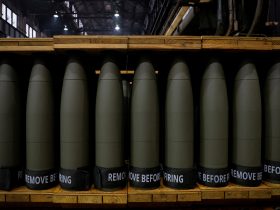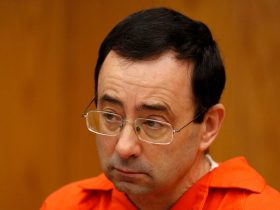Delhi, the battling of winter surge in India’s capital in Covid-19 cases as temperatures plummet and air air pollution rises to harmful ranges.
The town confirmed greater than 8,500 instances on Wednesday alone, its highest daily report, but.
It additionally added 85 deaths in a day, placing the whole past 7,000.
The sharp spike in instances after a month-long lull has additionally put stress on hospitals – greater than half of their beds are already occupied.
Chief Minister Arvind Kejriwal has written to the federal authorities asking for extra beds at sources hospitals as public stress mounts.
At 8.6m and counting, India presently has the world’s second-highest caseload. But it indeed had been on the decline from the center of September: everyday case counts dropped from practically 100,000 to as little as 37,000 within the weeks that adopted, while testing remained constant.
Every nationwide day tally continues to hover between 40,000-50,000 – India recorded some 48,200 instances on Wednesday.
Everyday instances in India’s worst-hit states.
However, Delhi has seen an alarming spike in recent weeks, recording extra new instances than every other state. The capital has confirmed only over 450,000 cases to this point, some 42,000 of that are energetic.
It comes as giant swathes of northern India confront a winter season and dangerously excessive air pollution ranges – two components that might considerably worsen efforts to regulate the virus in response to consultants.
The rising numbers also coincide with India’s busy competition season, with Hindus celebrating Diwali this weekend. Delhi has banned the sale, and the use of fireworks and officers have bolstered the necessity for social distancing. However, visuals of crowds thronging markets within the metropolis have precipitated alarm.
Authorities discovered an excessive positivity price amongst shopkeepers in a number of the oldest markets prone to changing into hotspots.
“Two aged sufferers of mine needed to look ahead to greater than 20 hours to get a mattress,” stated Dr. Joyeeta Basu, a doctor in Delhi.
Almost 8,600 beds out of the 16,573 Covid beds in Delhi’s private and non-private hospitals have been full as of Wednesday night, responding to the federal government’s Corona app.
However, extra worryingly, unoccupied beds in intensive care models (ICU) are extra scarce – solely 176 beds with ventilators and 338 beds without ventilators can be found. On Thursday, the Delhi Excessive Court docket stated some 33 private hospitals might reserve 80% of ICU beds for Covid sufferers due to spiraling instances and strained hospital assets.
A big crowd is seen at Lajpat Nagar central market forward of the Diwali competition on November 10, 2020, in New Delhi, India.
Residents in Delhi have flocked to markets throughout the festive season.
Docs say the pandemic is raging inside town’s hospitals, the place free beds are getting stuffed up by the minute.
Hundreds of beds within the government-owned hospitals stay free in response to the app. However, there are no vacant beds in at the very least 24 private hospitals, and fewer than 50 can be found throughout 80 private hospitals listed on the app.
However, many who can afford personal healthcare won’t select to go to a public hospital in India, the place the standard of infrastructure is commonly more flawed. India has an abysmal report in general well being, spending only over 1% of its GDP.
“All of my sufferers would solely go to a non-public hospital. However, with the best way issues are going, we could need to accept no matter beds we will get within the coming days,” Dr. Basu added.
Dr. Randeep Guleria, director at All India Institute of Medical Sciences, one of India’s largest public hospitals, informed native media that the spike means sufferers requiring admission into hospitals will rise.
“Moreover, there is a rise within the variety of sufferers coming to the emergency [room] with acute respiratory issues due to air air pollution and respiratory viral infections”.
Has the pandemic peaked in India?
Air high-quality displays Show that air pollution ranges are 14 instances larger than the World Well being Group’s (WHO) secure ranges.
One other worrying issue is that normal immunity in a colder climate is lowered no matter one’s age or comorbidities, in response to Prof Ok Srinath Reddy, president of the Public Well being Basis of India, a Delhi-based assume tank.
Chilly climate can be extra hospitable to the virus, whose survival time rises in the dry and cold air, he stated.
“Chilly air is a heavier and fewer cell, which implies viral clouds or viral particles will hover nearer to the bottom, making it simpler to get into one’s lungs.”
Add air pollution to this situation, and it is “a double whammy,” he added, as cooler air implies that pollution will stick around longer.
Research worldwide has linked air pollution to increased Covid-19 case numbers and deaths. A Harvard College examination confirmed that a rise of just one microgram per cubic meter in PM 2.5 – tiny harmful pollution within the air – is related to an 8% enhance within the Covid-19 dying price.
One other examination by Cambridge College discovered a hyperlink between the severity of Covid-19 an infection and long-term publicity to air pollution, together with nitrogen oxides, automotive exhaust fumes, or burning of fossil fuels.
“We’ve to maintain our fingers crossed,” stated Prof Reddy, including that Delhi initially felt pressure when instances shot up in April. “It began to come back again down in June once we had a hotter climate and a lot better air.”
European nations like France and Italy, which grabbed headlines initially of the pandemic for rising instances, have been hit arduous in January and February beneath a harsh winter, he stated.
“That is the primary time we must take care of the virus beneath a winter season so we won’t go by what occurred in the summertime. We will be extra weak.”















Leave a Reply